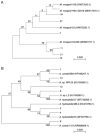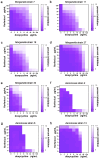Synergistic Efficacy of Doxycycline and Florfenicol Against Aeromonas hydrophilia and Morganella morganii Infections in Pelodiscus sinensis with Skin Ulcer Disease
- PMID: 40711271
- PMCID: PMC12298653
- DOI: 10.3390/vetsci12070611
Synergistic Efficacy of Doxycycline and Florfenicol Against Aeromonas hydrophilia and Morganella morganii Infections in Pelodiscus sinensis with Skin Ulcer Disease
Abstract
The intensive farming of Pelodiscus sinensis (P. sinensis) for its medicinal and economic value has led to an increased incidence of bacterial skin infections, commonly treated with antibiotics. However, rising antibiotic resistance has reduced the effectiveness of these treatments, highlighting an urgent need for alternative therapeutic approaches. In this study, we isolated and identified pathogenic bacteria (Aeromonas and Morganella) from P. sinensis affected by skin ulcer disease at a turtle farm in Beijing. Antibiotic resistance was evaluated using the checkerboard microdilution method and the in vitro antibacterial efficacy of a florfenicol-doxycycline combination therapy was assessed. A total of 30 bacterial isolates were obtained, primarily Morganella and Aeromonas species. Among these, 83.3% of Morganella and 57.14% of Aeromonas isolates demonstrated multidrug-resistance. The florfenicol-doxycycline combination yielded lower fractional inhibitory concentration (FIC) values, indicating synergistic or additive effects. Animal experiments have shown that florfenicol in combination with doxycycline can achieve better therapeutic effects with less drug. These findings support that combination antibiotic therapies help in managing skin ulcer disease in P. sinensis and offer valuable insights for clinical applications.
Keywords: Pelodiscus sinensis; antibiotic resistance; combination therapy; skin ulcer disease.
Conflict of interest statement
The authors declare no conflicts of interest.
Figures





Similar articles
-
Enhancing colistin efficacy with combination therapies for multidrug-resistant P. aeruginosa and A. baumannii isolates.Future Microbiol. 2025 May-Jun;20(7-9):523-531. doi: 10.1080/17460913.2025.2490377. Epub 2025 Apr 10. Future Microbiol. 2025. PMID: 40208781
-
Drugs for treating Buruli ulcer (Mycobacterium ulcerans disease).Cochrane Database Syst Rev. 2018 Aug 23;8(8):CD012118. doi: 10.1002/14651858.CD012118.pub2. Cochrane Database Syst Rev. 2018. PMID: 30136733 Free PMC article.
-
Helicobacter pylori and gastric or duodenal ulcer.Prescrire Int. 2016 Jan;25(167):18-23. Prescrire Int. 2016. PMID: 26942258
-
Effectiveness of rifampicin-streptomycin for treatment of Buruli ulcer: a systematic review.JBI Database System Rev Implement Rep. 2017 Jan;15(1):119-139. doi: 10.11124/JBISRIR-2016-003235. JBI Database System Rev Implement Rep. 2017. PMID: 28085731
-
Systemic pharmacological treatments for chronic plaque psoriasis: a network meta-analysis.Cochrane Database Syst Rev. 2017 Dec 22;12(12):CD011535. doi: 10.1002/14651858.CD011535.pub2. Cochrane Database Syst Rev. 2017. Update in: Cochrane Database Syst Rev. 2020 Jan 9;1:CD011535. doi: 10.1002/14651858.CD011535.pub3. PMID: 29271481 Free PMC article. Updated.
References
Grants and funding
- KM202310020006/Program of Beijing Municipal Education Commission, grant number
- BYESS2023192/Young Elite Scientists Sponsorship Program by BAST
- QJKC-2022052/2022 Research and Innovation Ability Improvement Plan for Young Teachers of Beijing University of Agriculture
- BUA-HHXD2023002/Science and Technology innovation support program of Beijing University of Agriculture
- BUA-QNTJ-2024001/Young Elite Scientists Sponsorship Program by BAST
LinkOut - more resources
Full Text Sources

